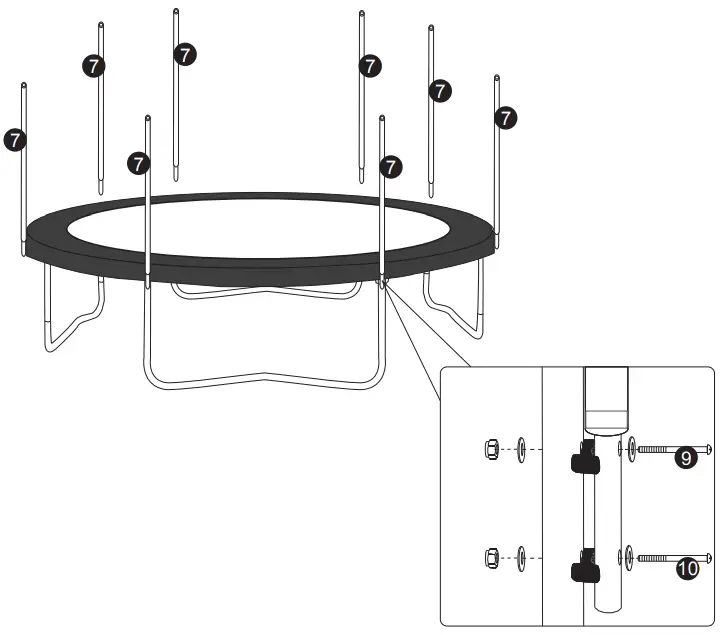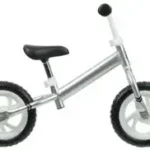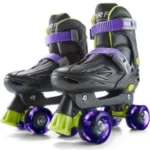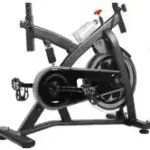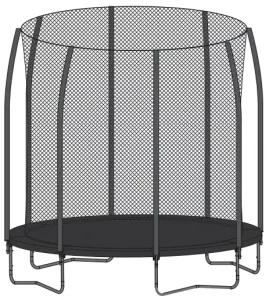
SPRINGLESS TRAMPOLINE
OWNER’S MANUAL 12FT (365cm)
SpnngLess Trampoline
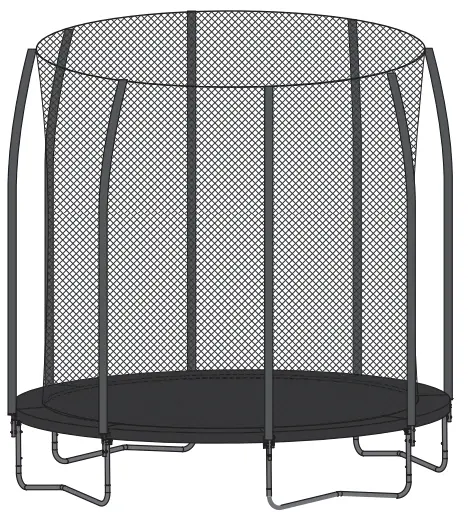
WARNING!
SAFETY INFORMATION, INSTALLATION, AND MAINTENANCE INSTRUCTIONS: READ THESE MATERIALS PRIOR TO ASSEMBLING AND USING THE TRAMPOLINE. PLEASE READJUST THE PRODUCT TO THE LOWEST HEIGHT AND STORE IT SAFELY WHEN NOT IN USE OR BEFORE BAD WEATHER WITH SEVERE WIND.
Important
The owner’s manual contains safety. assembly, use, and maintenance instructions The PRODUCT must be assembled by an adult who has read and understand these instructions Keep the packaging away from children and dispose of all packaging before use. It is best to keep the instructions for future reference.
For the installer and your children’s safety, it is important to fully read and understand the instructions and safety hazards before commencing the assembly of the product. It is advised to retain the manual for future reference.
CUSTOMER SERVICE:
Name: JCA Collective: Email: [email protected]
Phone Number: +61 423 259 751
Office Hours: Monday to Friday 9 am to 5 pm
GENERAL SAFETY INSTRUCTIONS
PURPOSE
The product is intended for home/domestic use only and is not suitable for professional or medical use.
DANGER FOR CHILDREN
- WARNING! Trampolines over 500mm (20 inches) in height are not recommended for children under six years of age.
- Children using the trampoline must be 6 years of age and over. This trampoline is designed and manufactured to provide you and your family with many years of fun and exercise, but for your benefit and safety, children using this trampoline must be adequately informed of all warnings and safety instructions.
- Do not let children unsupervised near this product. Carry out the suitable settings in the product by yourself and supervise the activity.
- Be aware that the packaging material is not suitable for children. There is the danger of suffocation!
RISK OF INJURIES
- Do not use the product if it is damaged or defective. In this case, please consult a qualified technician.
- Check the product before every use. Defective parts must be changed immediately as they can impair the function and the safety of the product.
- Make sure that no more than one person is using the product at the same time.
- Use the product only on even and non-slipping surfaces. Never use it near water and keep sufficient space around it to increase security.
- Beware of moving pads, which could catch your arms and legs. Do not stick any objects in the product’s openings.
ATTENTION -PRODUCT DAMAGE
- Please do not alter the product. Only use original spare pads. Qualified technicians should only carry out repairs — improper repairs can lead to danger for the user. Use this product only as described in this manual.
- Protect the product against splashes, humidity, high temperature
ASSEMBLY ADVICE
- The assembly of the product must be done carefully and by two able-bodied adults. If in any doubt, ask technically qualified personnel.
- Before you start with the assembly, read the instructions carefully and take a look at the assembly instructions.
- Remove all packaging materials and lay down all parts on a free space. This gives you an overview and simplifies the assembly procedure.
- Now, check with the parts list that no part is missing. Dispose of the packaging material when the assembly is completed.
- Beware that when using tools or doing technical work, there is always a risk of injuries. Therefore assemble the product carefully.
- Create a danger-free environment; for example, do not let tools lay around the Store the packaging material in a way that cannot cause any danger. Foils and plastic bags are dangerous for children (danger of suffocation)!
- After installing the product according to the instruction manual, please make sure that all screws, bolts, and nuts are correctly installed and tightened and that all joints are tightly
- A free space of at least 8m is necessary above the trampoline. An appropriate free space must be kept between the trampoline and possible sources of danger, such as electric cables, Tree branches, Playing devices, Swimming pools, and fences,
- The Trampoline must be set up properly before use.
- Never set up the trampoline in heavy rain, wind or storm conditions, especially lightning It is recommended that the trampoline be taken apart and stored in bad weather.
- The metal frame of the trampoline will conduct electricity. Lightning, extension cords, and all electrical equipment must never be allowed to come in contact with the trampoline.
- The Trampoline must always be used in a well-lit area.
- Nothing must be placed under the trampoline.
- The Trampoline in the vicinity of other leisure devices and constructions must not be
- When assembling or disassembling, please use gloves to protect your hands.
SAFETY INSTRUCTIONS FOR YOUR
WARNINGS!
![]() Do not land on the head or neck.
Do not land on the head or neck.
Do not attempt or allow somersaults.
Landing on your head or neck can cause serious injury, paralysis. or death. even when landing in the middle of the bed
If an enclosure is fitted•do not pull top of the net.
![]() Ensure adult supervision is provided at all times.
Ensure adult supervision is provided at all times.
Only one person at a time on the trampoline.
Do not allow more than one person on the trampoline. Use by more than one person at the same time increases the chance of injury.
Misuse and abuse of this Campione can cause serious injuries.
This trampoline is not recommended for children under 6 years of age.
- Do not use the trampoline without supervision, regardless of age and experience.
- The safety instructions of the trampoline should always be considered and obeyed. During the use of the trampoline, there is a heavy danger of injury including permanent injuries such as paralysis, or even death.
- Even landings on the trampoline can lead to injuries, particularly to the back, neck or head. Somersaults must be avoided. In any case, only one person should use the Trampoline at a time.
- The importer, store, manufacturer nor supplier will be responsible or liable in any form for direct, indirect or special damages caused during the use or in connection with the product.
- This also applies to financial losses by theft, property loss, loss of earnings/services and profit, loss of satisfaction in the device, costs of the installation, disposal, damage by influences of the weather and environment as well as any other kinds of damages.
- Recognizable production defects are announced immediately by the dealer or manufacturer/ importer and shall be adjusted immediately for further use. The buyer/Operator of the trampoline has to examine the device regularly on wear or
- No clothes with hooks or parts may be carried when jumping on the trampoline, in order to avoid hooks getting caught.
- The trampoline may be set up only on flat ground.
- Strong winds can blow the Trampoline away. If strong winds are predicted, the Trampoline must be moved to a protected place, and taken apart, or fastened to the ground with cords and herrings. At least three anchorages are necessary. It is not enough to anchor the pennants in the ground since they can tear out of the patch cords.
- Try to avoid moving the assembled trampoline, because it could bend during transportation. Should it be necessary to move the trampoline, please consider the following:
1.)At least four people must be evenly spaced around the frame to lift the trampoline of the ground.
2.)The trampoline must be carried horizontally
3.)Be careful while moving, because the frame could bend. If this happens, use four people to draw the trampoline in shape. - Trampolines are jumping devices, enabling the user to jump into unusual heights as well as into a multiplicity of body movements. Jumping in the Trampoline, hitting the frame, cushioning, or incorrect landing on the Trampoline can lead to injuries.
- All users must read the recommendations of the manufacturer themselves to ensure they use the device correctly.
- Users should be familiar with the assembly manual. This manual contains assembly guidance; selected precautionary measures as well as recommendations for servicing and maintenance of the trampoline, in order to ensure a secured and fun use of the Trampoline.
- It is the responsibility of the owner or the supervisor to guarantee that all users of the trampoline are informed sufficiently of all warning references and safety instructions.
FOR THE SUPERVISOR:
The supervisor’s role is to make sure the users know all the safety rules as well as learn the basic, fundamental bounces. They need to enforce all the safety rules and warnings in the manual, frame, and labels. When a supervisor is not available, the trampoline may be disassembled or covered to limit access.
- Implement all safety rules and make yourselves familiar with the information in the user
- All users of the trampoline need a supervisor, regardless of the age and the experience of the user.
- Do not recommend this trampoline for children under 6 years of age.
- The trampoline can be only used if the jumping mat is clean and dry. Worn or damaged jumping mats should immediately be replaced.
- Objects, which could be dangerous to the user, should be away from the trampoline
- Avoid unauthorized and unsupervised use of the trampoline.
- Do not use the Trampoline under influence of alcohol or drugs (incl. medicines).
- Learn the fundamental jump and body positions carefully, before trying difficult jumps.
- Stop jumping by bending your knees when your feet come to contact with The skill of braking should be used whenever you lose balance or control from a previous maneuver. Loss of balance or control will increase the risk of injury from landing on the frame, springs or completely off the trampoline. A controlled jump is considered landing on the same spot that you took off from .1f you do lose control when you are jumping on the trampoline, bend your knees sharply when you land and this will allow you to regain control and stop your jump.
- Climb onto the trampoline. Do not jump on it directly. Do not use the trampoline as a jumping board for other articles.
ACCIDENT CATEGORIES
Somersaults: A landing on the head or neck increases the risk of neck and back injuries, which can lead to paralysis and sometimes death. This can occur if the user makes an error and falls forward or backward. No somersaults should be attempted on the trampoline.
The probability of an injury increases if more than one person is jumping on a trampoline. Users can collide, fall off the trampoline, Iand improperly on the jumping mat and on each other. Smaller users will more easily be hurt in this case.
Climbing on or off the trampoline: The trampoline’s jumping mat is approximately one meter above the ground. Jumping off the trampoline onto the ground or another surface can lead to an injury. Jumping onto the trampoline from a building roof, a terrace or other objects can lead to injury. Small children need assistance when climbing on or off the trampoline. Be careful when climbing on and off the trampoline. Do not step on the cushioning or the framework. Do not use the framework for climbing on or off the trampoline.
Hitting the framework or the springs: When playing on the trampoline, stay in the center of the mat. This will reduce your risk of getting injured by landing on the frame of springs. Always keep the frame pad covering the frame of the trampoline. DO NOT jump or step onto the frame pad directly since it is not intended to support the weight of a person.
Loss of control: when users lose control of their jump, they can land wrongly on the jump mat, land on the framework or the cushioning, or fall down from the Trampoline. A controlled jump is one where the jumper lands and jumps from the same spot. Before a more difficult jump maneuver is practiced, the basic controlled jump should be mastered perfectly and continuously. If a jump maneuver is attempted, which exceeds the abilities of the jumper; there is a danger of losing control. In order to regain control of the jump and land correctly, the knees should be completely bent upon landing.
Under influence of drugs or alcohol: The probability of an injury rises if the user is under the influence of alcohol or drugs. These substances weaken the response, the faculty of judgment, spatial awareness, coordination, and motor functions of the user.
Collision with objects: while using the trampoline, person, animals, or articles under it will increase the probability of an injury. Jumping on the trampoline while carrying an article, increases the probability of an injury. Placing the trampoline too close to electric wires, tree branches or other obstacles will increase the probability of an injury.
Bad maintenance of the Trampoline: Users can hurt themselves if the trampoline is in bad condition. A torn jumping mat, bent framework, missing cushioning or missing framework must be replaced before using the trampoline again. The trampoline should be examined before each use.
Weather conditions: A wet jumping mat is too slippery for safe jumping. Gusty or strong winds can lead to a loss of jump control when jumping. In order to lower the probability of an injury, the trampoline should be used under suitable weather conditions only.
Please readjust the product to the lowest height and store it safely when not in use or before bad weather with severe wind
METHODS OF ACCIDENT PREVENTION
Role of the user in preventing accidents:
Basic knowledge of the trampoline by the user is a must for security. All users of the trampoline must learn first how to accomplish a low controlled jump as well as the fundamental landing positions and combinations, before turning to advance jump exercises. Users must know why they must control their jump, before they may practice other movements. A controlled jump is when you land and take off from the same location. The first lesson is the understanding of the correct order in developing jumping skills on a Trampoline. For further information or exercise materials, please turn to a trained Trampoline teacher.
Role of the supervisor in preventing accidents:
It lies in the responsibility of the supervisors to guarantee reasonable and experienced supervision of the users of a trampoline. Rules and warnings in this manual must be applied, and known to the users of the trampoline in order to reduce the probability of accidents and injuries. In times, when the supervision is not possible or insufficient, the trampoline should be dismantled and stored in a secured place against unauthorized use.
SAFE USE INSTRUCTIONS
A) Read all instructions before using the trampoline.
B) Allow only one person on the trampoline at any time. Use by more than one person at the same time can result in serious injury.
C) Use the trampoline only with mature, knowledgeable supervision at all times.
D) Inspect the trampoline before each use. Make sure the frame padding is correctly and securely positioned. Replace any worn, defective,
or missing parts.
E) Keep objects away which could interfere with the user. Maintain a clear area around, above, and under the trampoline.
F) Learn fundamental bounces and body positions thoroughly before trying more advanced skills.
SITTING INSTRUCTIONS
- Adequate overhead clearance is essential. A minimum of 8 m from ground level is Provides clearance for wires, tree limbs, and other possible hazards.
- Lateral clearance is essential. Place the trampoline away from walls, structures, fences, and other play areas.
- Maintain a free space of a minimum of 2500 mm on all sides of the trampoline. This area should not include concrete, bitumen, brick, or other hard surfaces as these can cause serious
NOTE: For trampolines with enclosures, the free space may be reduced to 1500 mm.
- Keep the trampoline on a level surface.
- Use the trampoline in a well-lighted area.
FOR TRAMPOLINES REQUIRING PADDING
- Inspect the trampoline before each use and replace any worn, defective, or missing
- The following conditions could represent potential hazards:
- Missing, improperly positioned, or insecurely attached frame padding.
- Punctures, frays, tears, or holes worn in the bed or frame padding.
- Deterioration in the stitching or fabric of the bed or frame padding.
- Broken or stretched springs.
- A bent or broken frame.
- A sagging bed.
ASSEMBLY INSTRUCTIONS
| NO. | Parts | Description | Qty |
| 1 | 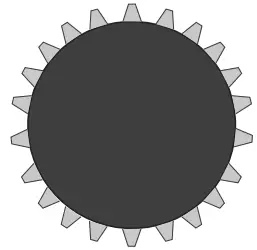 |
Mat | 1 |
| 2 |  |
Pad | 1 |
| 3 | 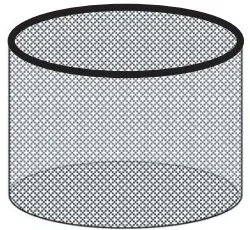 |
Eclosure Net |
1 |
| 4 |  |
Top rail | 8 |
| 5 |  |
Leg extension | 8 |
| 6 |  |
Leg | 4 |
| 7 |  |
Lower enclosure pole |
8 |
| 8 | ‘ |
Upper enclosure pole |
8 |
| 9 |  |
Leg to frame hardware |
8 |
| 10 |  |
Leg to frame hardware |
8 |
| 11 | 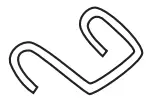 |
Trampoline mat metal clips |
72 |
| 12 |  |
Steel top rim | 8 |
| 13 |  |
Steel rim connector |
8 |
| 14 |  |
Wrench | 1 |
| 15 |  |
hexagon wrench | 1 |
| 16 |  |
Spring tool | 1 |
| 17 |  |
Enclosure net tie-down strap |
1 |
Assemble the frame
STEP 1
- Layout the top rail (part 1), leg extension (part 2), and leg base (part 3) as pictured in the diagram.
- Begin by assembling all the leg extensions with the leg base. Connect the leg extension to the base ensuring the locking pin locks into place
- Once all the legs are assembled connect the top rails to the top of the leg extensions, once again ensuring the locking in locks in place.
Be sure to connect the top rails to each other as you go. - Once complete check all connections and ensure they have been locked into place.
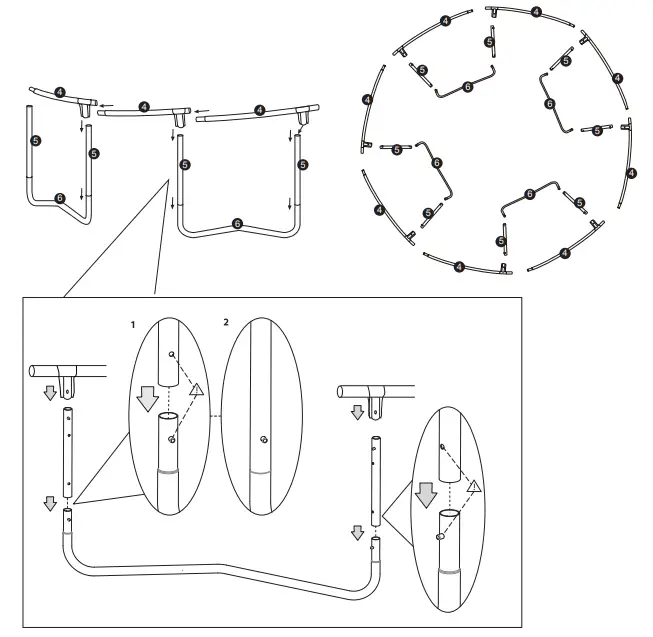
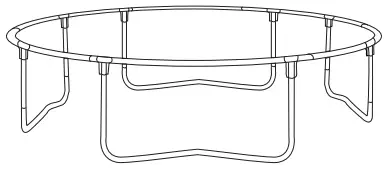
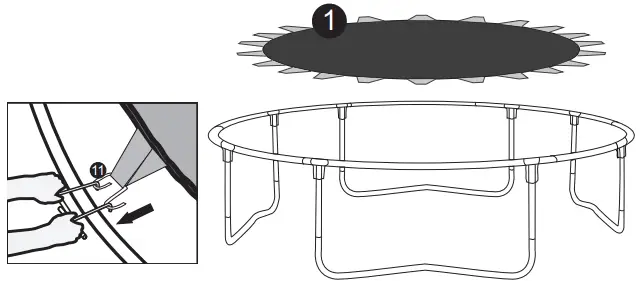
STEP 2
Assemble the Mat
- Layout the mat in the center of the assembled frame ensuring the top is facing upwards
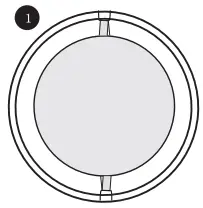
- Take the trampoline mat metal clips (part 12) and feed through the strat at the edge of the trampoline mat.
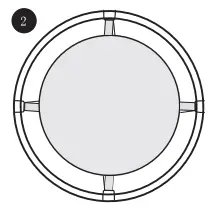
- Take the supplied spring hook tool and pull the strap back until the metal clip can hook over the top rail. Be sure to follow the order displayed in the diagrams above.
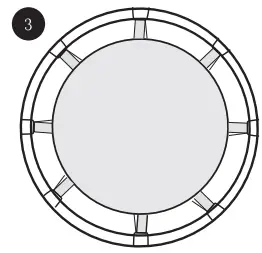
- Continue until all the hooks are clipped over the top rail.
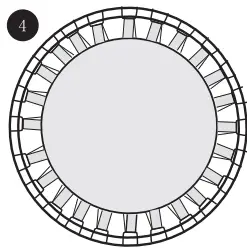
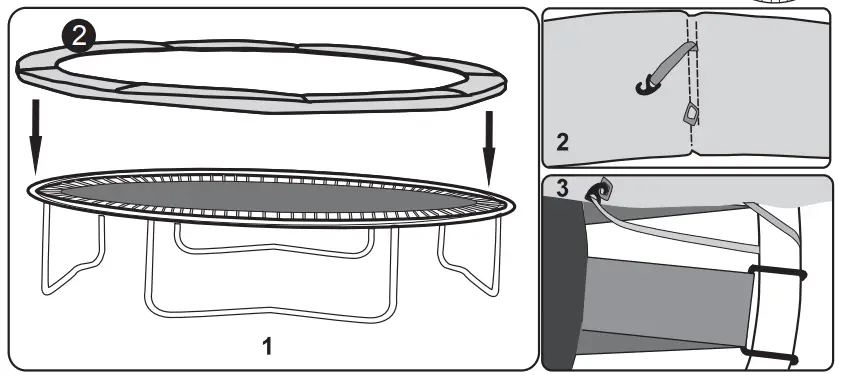
STEP 3
Assemble the Padding
- Layout the padding over the trampoline straps and frame top rail so they are completely covered.
- Take the padding tie-downs located around the pad and tie around the
frame top rail ensuring it is tied down tightly. - Tie the outer strap around the trampoline frame and the inner strap around the elastic straps on the mat.
STEP 4
Assemb le the Net tubes
- Place the Lower Net tube against the leg extension ensuring they align vertically. There are 8 elastic straps on the pad, the lower pole needs through the strap as picture 1 shows.
- Take the supplied bolt and nuts and lining up the holes in the leg extension and the Lower Net Tube insert the screw through both poles.
- Screw the nut onto the bolt and tighten to secure.
- Repeat steps 2-3 for the second bolt and screw on each leg.
- Repeat for all poles.
